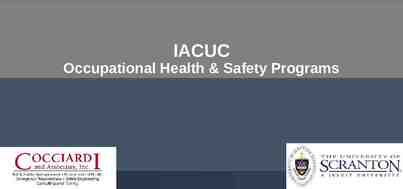Overview of the Six Step Planning Process
31 Slides1.36 MB
Overview of the Six Step Planning Process
Introduction and Purpose Schools Provide safe and healthy learning environments Keep children and youths safe from threats and hazards In collaboration with their local government and community partners, schools can Plan for these potential emergencies, and Create school emergency operations plans (EOPs).
PPD 8 & Five Preparedness Missions Prevention Recovery Mitigation Response Before Protection During After an incident or emergency
Reflections on Professional Practice Planning Principles Supported by Leadership Uses Assessments to Customize Collaborative Process Considers All Settings and All Times Takes an AllHazards Approach Provides for Whole School Community
The Planning Process Is flexible and can be adapted to accommodate a district’s and a school’s unique characteristics and situation. During the planning process it is critical that schools work with their district staff and community partners—local emergency management staff, first responders, and public and mental health officials-during the planning process.
Steps in the Planning Process
Step 1 Form a Common Framework Define and Assign Roles and Responsibilities Determine a Regular Schedule of Meetings
Step 2 Identify Threats and Hazards: The planning team first needs to understand the threats and hazards faced by the school and the surrounding community. Assess the Risk Posed by the Identified Threats and Hazards: Once an initial set of threats and hazards have been identified, the planning team should evaluate and prioritize the vulnerability and risk posed by the identified threats and hazards. Assessments will be used not only to develop the initial plan but also to inform updates and revisions to the plan on an ongoing basis.
Step 2: Understand the Situation (1 of 7) SITE ASSESSMENT Description: Examines the safety, accessibility, and emergency preparedness of the school’s buildings and grounds. Purpose: To provide an increased understanding of potential impact of threats and hazards on the school buildings and grounds. To identify risks and vulnerabilities of the school buildings and grounds. To identify which facilities are physically accessible to individuals with disabilities and others with functional and access needs, including language, transportation, and medical needs, and can be used in compliance with the law.
Step 2: Understand the Situation (2 of 7) CULTURE & CLIMATE ASSESSMENT Description: Evaluates students and staff connectedness to the school and problem behaviors. Purpose: To provide knowledge of students’ and staff’s perceptions of their safety. To provide knowledge of problem behaviors that need to be addressed to improve school climate.
Step 2: Understand the Situation (3 of 7) BEHAVIORAL THREAT ASSESSMENT Description: Analyzes communication and behaviors to determine whether or not a student, staff, or other person may pose a threat. Purpose: To assure students, staff, or other persons who may pose a threat are identified and referred for services (if appropriate) before a threat develops into an incident.
Step 2: Understand the Situation (4 of 7) Behavioral Threat Assessment (Cont.) Key Findings from the SSI Rarely sudden, impulsive acts Others knew in advance Many attackers felt bullied Most had access to weapons Prior behavior caused concern Difficulty coping with loss or failures Other students involved Most stopped by someone other than law enforcement
Step 2: Understand the Situation (5 of 7) CAPACITY ASSESSMENT Description: Examines the capabilities of students and staff, as well as the services and material resources of community partners. Purpose: To provide an increased understanding of the resources available. To provide information about staff capabilities to help planners assign roles and responsibilities in the plan.
Step 2: Understand the Situation (6 of 7) One effective method for organizing information is to create a table with a range of information about each possible threat and hazard, including any new threats or hazards identified through the assessment process. The table should include: Probability or frequency of occurrence; Magnitude; Time available to warn staff, students, and visitors; Duration; and Follow-on and cascading effects of threat or hazard. Prioritize Threats and Hazards Next, the planning team should use the information it has organized to compare and prioritize risks posed by threats and hazards.
Step 2: Understand the Situation (7 of 7) Hazard Probability Magnitude Warning Duration Risk Priority Fire 4. Highly likely 3. Likely 2. Possible 1. Unlikely 4. Catastrophic 3. Critical 2. Limited 1. Negligible 4. Minimal 3. 6–12 hrs. 2. 12–24 hrs. 1. 24 hrs. 4. 12 hrs. 3. 6–12 hrs. 2. 2–6 hrs. 1. 3 hrs. High Medium Low Hazmat spill outside the school 4. Highly likely 3. Likely 2. Possible 1. Unlikely 4. Catastrophic 3. Critical 2. Limited 1. Negligible 4. Minimal 3. 6–12 hrs. 2. 12–24 hrs. 1. 24 hrs. 4. 12 hrs. 3. 6–12 hrs. 2. 2–6 hrs. 1. 3 hrs. High Medium Low After completing Step 2, the planning team has a prioritized (high, medium, or low risk) list of threats and hazards based on the results of the risk assessment.
Step 3 The planning team Decides which of the threats and hazards identified in Step 2 will be addressed in the school EOP Develops goals and objectives for each threat and hazard Using the approach 1. Before 2. During 3. After
Step 3: Determine Goals and Objectives (1 of 2)
Step 3: Determine Goals and Objectives (2 of 2) Often, planners will need to identify multiple objectives in support of a single goal. After the team has finished compiling the objectives for the prioritized threats and hazards, it will find that certain critical “functions” or activities apply to more than one threat or hazard. After identifying these functions, the planning team should develop three goals for each function. These commonly occurring functions will be contained in a “Functional Annex” within the school EOP.
Step 4 Identify Courses of Action Courses of action include criteria for determining how and when each response will be implemented under a variety of circumstances. Subsequently, the planning team develops response protocols and procedures to support these efforts. Possible courses of action are typically developed using the following steps: 1. 2. 3. 4. Depict the scenario. Determine the amount of time available to respond. Identify decision points. Develop courses of action.
Step 4: Plan Development (Identifying Courses of Action) Select Courses of Action After developing courses of action, planners compare the costs and benefits of each proposed course of action against the goals and objectives. Based on this comparison, planners select the preferred course or courses of action to move forward in the planning process. After selecting courses of action The planning team identifies resources necessary to accomplish each course of action without regard to resource availability. Once the planning team identifies all of the requirements, it begins matching available resources to requirements.
Step 5 Format the Plan An effective school EOP is presented in a way that makes it easy for users to find the information they need and that is compatible with local and state plans. Write the Plan As the planning team works through the draft, the members add necessary tables, charts, and other supporting graphics. Review the Plan Planners should check the written plan for compliance with applicable laws and for its usefulness in practice. Approve and Share the Plan After finalizing the plan, the planning team should present it to the appropriate leadership and obtain official approval of the plan. The team should then share the plan with its community partners who have a responsibility in the plan.
Step 5: Plan Preparation, Review, and Approval (1 of 4) SCHOOL EMERGENCY OPERATIONS PLAN BASIC PLAN FUNCTIONAL ANNEXES THREAT- AND HAZARDSPECIFIC ANNEXES
Step 5: Plan Preparation, Review, and Approval (2 of 4) Introductory Material Purpose and Situation Overview Basic Plan Concept of Operations Organization and Assignment of Responsibilities Direction, Control, and Coordination Information Collection, Analysis, and Dissemination Training and Exercises Administration, Finance, and Logistics Plan Development and Maintenance Authorities and References
Step 5: Plan Preparation, Review, and Approval (3 of 4) Communications and Warning Evacuation Lockdown Shelter-in-Place Accounting for All Persons Family Reunification Security Continuity of Operations Recovery Health: Public, Medical, and Mental Functional Annexes
Functions Can Occur Consecutively Shelter-in-Place Evacuation Concurrently Evacuation Accounting for Students, Staff, and Visitors
Step 5: Plan Preparation, Review, and Approval (4 of 4) Natural Hazards Threat- and HazardSpecific Annexes Technological Hazards Biological Hazards Adversarial, Incidental, and Human-Caused Threats
Threat- and Hazard-Specific Annexes Natural Hazards Earthquakes Tornadoes Lightning Severe wind Hurricanes Floods Wildfires Extreme temperatures Landslides or mudslides Tsunamis Volcanic eruptions Winter precipitation Technological Hazards Biological Hazards Explosions or accidental release of toxins from industrial plans Accidental release of hazardous materials from within the school, such as gas leaks or laboratory spills Hazardous materials releases from major highways or railroads Radiological releases from nuclear power stations Dam failure Power failure Water failure Infectious diseases, such as pandemic influenza, extensively drug-resistant tuberculosis, Staphylococcus aureus, and meningitis Contaminated food outbreaks, including Salmonella, botulism, and E. coli Toxic materials present in school laboratories Adversarial, Incidental, and Human-caused Threats Fire Active shooters Criminal threats or actions Gang violence Bomb threats Domestic violence and abuse Cyber attacks Suicide
Step 6 Visit Key Locations Distribute Materials Hold a Meeting Teach Roles and Responsibilities Train Stakeholders on Plan and Roles Include Community Partners
Step 6: Plan Implementation and Maintenance (1 of 2) Exercise the Plan The more a plan is practiced and stakeholders are trained on the plan, the more effectively they will be able to act before, during, and after an emergency to lessen the impact on life and property. Tabletop Exercises Drills Functional Exercises Full-Scale Exercises
Step 6: Plan Implementation and Maintenance (2 of 2) Revise Review Maintain
Further Information Phone: (855) 781-7367 (REMS) Email: [email protected] http://rems.ed.gov Join our Com munity of Pra ctice! Access Virtua l Trainings Get the Guide Request an On-site Training




































